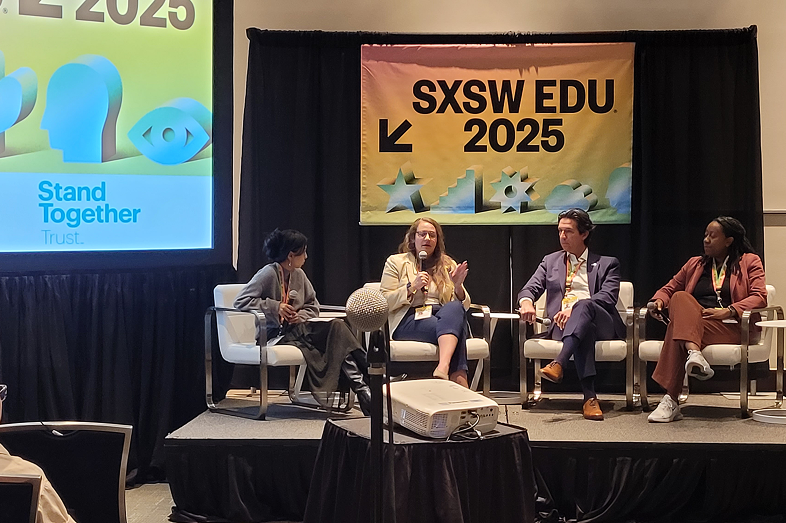Panelists discussed career and technical education (CTE) and other opportunities to put students on the path to good jobs during an Education Writers Association session at the March 2025 SXSW EDU conference in Austin, Texas.
The conversation detailed the benefits and drawbacks of educational programs, as well as how to ensure that companies are engaged in their employees’ continued success. Speakers also talked about the disconnect that often exists between what schools teach and what employers need.
Here’s what reporters should know about the session, which was moderated by Sneha Day, an education pathways reporter at The Texas Tribune.
Participants
- Terri-Ann Brown, director at Miami Tech Works
- Kerry McKittrick, co-director at The Project on Workforce at Harvard University
- Steve Partridge, vice president for strategy, research and workforce innovation at Northern Virginia Community College
Top Takeaways
Skills disconnect
- About 40% of college grads are underemployed, meaning their work does not match their full abilities, said Kerry McKittrick, co-director at The Project on Workforce at Harvard University. Meanwhile, regional economies are suffering because they can’t find workers in industries, such as health care and manufacturing. “Some of the best examples of solving this problem are really when colleges and employers are able to partner and align those pathways,” she said.
- A blind spot for some higher education institutions is keeping up with the changing skill sets required across different sectors, said Steve Partridge, a vice president at Northern Virginia Community College. Businesses have been filling that void by launching their own online certificate and credential programs.
- Place-based learning like internships, apprenticeships and micro internships are effective ways to boost students’ abilities in a way that is directly tailored to their industry, said Terri-Ann Brown, director at Miami Tech Works.
“What I say to employers all the time is that everything that academia and training providers do is for their benefit,” Brown said. “And so they have to become an active participant in this process if they want to get the end result that they want to see.”
Longevity of skills
- Artificial intelligence can pose a challenge to the workforce as the technology takes on responsibilities that people previously handled, the panelists said. “We need to be even more agile as skills change,” McKittrick said. “The half life of skills is dropping rapidly, and so people need to be able to become lifelong learners.”
- Short-term credentialing programs can help a community prioritize continuous, lifelong learning, Partridge said. At Northern Virginia Community College, he relies on wage data to determine how to design programs for students’ maximum benefit.
Look local
- In South Florida, Miami Tech Works collaborated with local businesses to identify how its programs could create a pipeline into their workplaces, Brown said. They created four working groups on tech skills, emerging tech, inclusivity in tech and small-business capacity building.
“What we did was create a regular cadence of intentional engagement between employers and training providers through these working group meetings virtually, but also creating capacity to bring the community together on a regular basis,” Brown said.
- Local small businesses have been examples of strong community college partners in South Florida, she added. They also benefit from continuing education program offerings.
“We are really in a crucial space in South Florida, where AI technology is growing at a really fast pace, and we wanted to open up clinics and workshops for small-business owners to go back and learn as technology was changing and growing, how they could begin to infuse this technology into their business,” she said.
Story Ideas
- What degrees in your region are not being utilized to their full potential? How can people use credential programs to fill gaps that could land them other jobs?
- What CTE programs yield long-term success in your community?
- What employers in your region are most committed to workplace-learning programs? Do employees have strong upward mobility within those workplaces?
- Which students finish the entire pathway process? Who doesn’t complete it, and how are they left behind?
- What unique challenges do student-athletes at your local colleges and universities face when pivoting from their sports to other jobs?
- What are some accessible place-based learning opportunities for students bolstering their skills in various industries?
Mistakes to Avoid
Discussions about pathways to good jobs aren’t just a binary between college and no college, panelists said.
- “There’s a variety of different options, a variety of on- and off-ramps that would be crucial and can provide different opportunities,” McKittrick said.
- “Some of those apprenticeship programs are more rigorous than college. So selling it [as] ‘It’s an easier way without going to college’ – it might be a cheaper way, but it’s not always the easiest way,” Partridge said.
Resources

